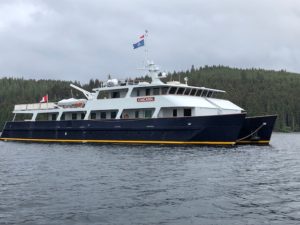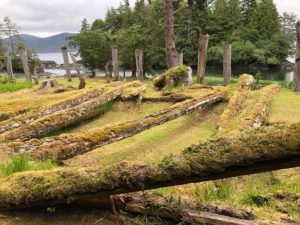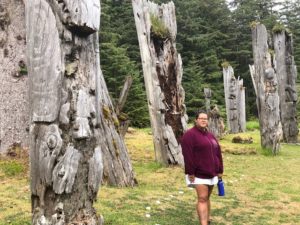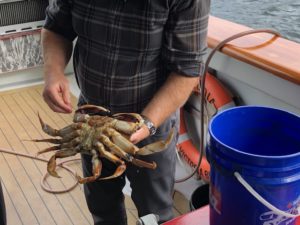
The expedition ship MV Cascadia sailed the Haida Gwaii islands. Photo by Robert Waite.
In Part II of Robert Waite’s chronicle of his trip to remote Haida Gwaii — an archipelago off the west coast of Canada, in British Columbia — he takes us aboard the MV Cascadia, a small expedition vessel that holds a maximum of 24 passengers.
Along with comfortable accommodations and amenities, the Cascadia provided plenty of opportunities for visiting the islands, formerly known as the Queen Charlottes, where the biological diversity is the richest on earth and Haida tribal culture is making a comeback.
If you haven’t read Part I of this two-part series, I suggest you go there now and you’ll have the full context for reading about this extraordinary journey.
By Robert Waite
Once aboard the Cascadia, much of our seven-day voyage was determined by weather and tides.
Tides on the east coast of Haida Gwaii can rise and fall upwards of 18 feet, not far off those of the world’s highest at the Bay of Fundy in Canada’s maritime provinces.
As for weather, in the summer it can best be described as cool and variable, with the potential for gale-driven storms. Although drier than in winter, a shower is always a possibility and it is prudent to bring along proper gear. Waterproof boots (for shore walkabouts) are provided.
Thanks to our vessel’s relatively shallow draft and the ability of the two landing craft to pull up right on shore, we were able to visit virtually all of the significant cultural and ecological sites along the long, undulating coast.
It should be noted that the Moresby Island coast is unlike any other you will likely see. The massive trees come right down to the tide’s high water line, which is marked by driftwood (and, sadly, man-made items) tossed up by winter storms.
Old Growth Forest
A few steps beyond is the old-growth forest. The high canopy crowds out light, keeping undergrowth and brush to a minimum. The combination of moss and pine needles creates the impression you are walking across a huge memory foam mattress. It is a space that commands reverence – in the words of Gordon Lightfoot, it is “a forest too quiet to be real.”
But of course the quiet is ultimately broken by your own footsteps along a path or boardwalk or by the sounds of ravens above.

A decaying six-pole longhouse, gradually being absorbed into the earth. Photo by Robert Waite.
Time was also spent on the water: aboard the Cascadia, in one of the two landing crafts, or kayaking into bays and inlets. We spotted three orcas from the vessel and encountered curious seals up close from the kayaks, which also allowed us to paddle right up to several waterfalls.
As we approached the cultural sites scattered down the Gwaii Haanas coastline, our expedition leader, Kevin Smith, would radio ahead to seek permission to land from the Haida Watchmen – individuals who act as guardians and guides during the summer months. The name comes from the practice of posting watchmen at strategic points around the village to warn of raids by intruders. Today they monitor the numbers allowed on shore and share oral histories and stories.
Smith, who has had a deep interest in Haida culture and the Haida Gwaii ecosystem since childhood in the BC gulf islands, offered us one over-arching piece of advice – to “slow down” and to “take a breath or two and pause to really experience these places.”
Each site has its own look and feel, but all are in decay, including the longhouses and the monumental poles. This is by design – these sites were decimated and largely abandoned during the period of the smallpox calamity and the Haida believe they should be allowed to return to the earth and forest. This includes the bones of their ancestors – paths are laid out, marked with white shells, to keep visitors from stepping on remains buried below.
SGang Gwaay – The Jewel
All of the sites, including Windy Bay, Tanu and Hot Spring, have their own features and stories (and Hot Spring does, indeed, have a hot spring that can accommodate about a dozen people). But the most moving is the most remote – SGang Gwaay in the far south of Gwaii Haanas National Park.

A Watchman explains the history and meaning of the monumental poles. Photo by Robert Waite.
Here the monumental poles are at their most majestic, strung along a beautiful sheltered tidal bay and with the collapsed but still discernible six-pole longhouses spread out behind.
Our Watchman, a young Haida woman named Shyla, explained the function of each pole. She also related that the longhouses were often seasonal and that the Haida typically took the flat sideboards of their dwellings with them, because creating a flat board from a large tree was so difficult using traditional tools.
Here, it takes little imagination to envision the place as a living, breathing village. It was difficult to leave such a place behind.
Aboard the Cascadia
Life aboard the M.V. Cascadia was very comfortable.
The cabins on the re-fitted New Zealand-built vessel are spacious and well appointed; the on-board cuisine was often augmented by items like Dungeness crab fresh from a trap put out the night before, a variety of fish (caught off the landing craft by a licensed crew member), or sea asparagus picked ashore by passengers themselves. It all ended up in the vessel’s galley in the capable hands of chef Mara Jornigan and, ultimately, on our plates.
Because the Cascadia is relatively small, passengers are free to roam about almost at will – to visit the bridge and the galley, and even get tours of the engine room by the ship’s engineer or of the crew quarters by a crewmember.
According to Expedition Leader Smith (who is also co-owner of Maple Leaf Adventures, the tour operator), the vessel was purpose-built during refitting to provide “upscale eco-tourism on the BC and Alaska coast.”

Expedition leader Kevin Smith holds a crab right out of the trap. Photo by Robert Waite.
“Upscale” goes beyond the fine dining and comfortable cabins – there is an open air hot tub on the bridge deck and also a helipad to reassure those nervous about being so remote from medical and other services.
There is also a presentation space on the main deck where Smith, Wade Davis and other crew members would lecture on Haida culture, the forests, or the whale population. These evening tutorials were so popular that several guests volunteered as well.
One, a geologist, presented on Haida Gwaii’s very active seismic attributes, while two other passengers discussed the work of artist Emily Carr and her depiction of memorial poles in some of her most famous paintings.
By the end of the voyage we all realised we had been treated to something very special and rare – a glimpse into a natural world largely unspoilt. We also experienced a culture on the mend, proud of its heritage and increasingly confident regarding its future.
Truly magical.
Author Bio: Robert Waite has written on travel for more than 45 years and has been published in the Boston Globe, San Francisco Examiner, Washington Post, Toronto Star, and The Globe & Mail, among others. A former Pacific News Service correspondent, he is now a professor at Seneca College in Toronto.
IF YOU GO
Recommended land accommodation on Haida Gwaii can be found at Jags Beanstalk, Skidegate http://www.jagsbeanstalk.com/ ($189 Canadian or US $142); expeditions are organized by Maple Leaf Adventures and include flights from Vancouver to Haida Gwaii. All-inclusive prices range from $10,100 Canadian per person (US $7,550) to $13,364 (US $10,023) https://mapleleafadventures.com/












Leave a Reply